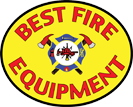What are the steps involved with hydrostatic testing?
Hydrostatic Test Service includes:
(1) If a charge remains on the cylinder, it is emptied and the charge is processed and recovered for re-use. Halon extinguishers require special equipment. The charge must be emptied into a Halon Recovery Chamber, to comply with environmental regulations.
(2) The head is removed
(3) The inside of the cylinder is inspected for any signs of damage, rust, or corrosion.
(4) The cylinder is filled with water and a high-pressure fitting is installed to allow pressure testing.
(5) Water is manually pumped into the cylinder until the internal pressure is 2-3 times the normal operating pressure for the cylinder (typically 585 PSI, or as specified by the manufacturer).
(6) Inlet valve is closed and the cylinder must maintain the minimum test pressure for at least 60 seconds.
(7) The cylinder is inspected to verify that there are no signs of leaks, cracks, or bulges that would indicate a defective cylinder.
(8) The pressure is then released and the cylinder is drained and thoroughly dried.
(9) Finally, if the cylinder passed all tests and inspections, a new Hydrostatic Test Label is attached to the cylinder per State Fire Marshal directives.
IF the cylinder fails any of these tests or inspections, it must be removed from service and replaced with a new extinguisher.
If the cylinder passes all tests and inspections, steps 2 – 9 of the Internal (Tear Down) Maintenance are performed and the cylinder is returned to service.
Internal (Tear Down) Maintenance includes:
(1) If a charge remains on the cylinder, it is emptied and the charge is processed and recovered for re-use.
(2) The head is disassembled, O-rings replaced, and valve is lubricated.
(3) Interior of the cylinder is inspected for signs of rust, corrosion, other deterioration.
(4) Hose / Nozzle assemblies are inspected and repaired or replaced as needed.
(5) Handle and other parts are inspected and repaired or replaced as needed.
(6) Cylinder is refilled with extinguishing agent to specified weight or volume.
(7) A “Verification of Service Collar” is installed per State Fire Marshal directives.
(8) Extinguisher is reassembled, pressurized, and tested for leaks.
(9) Finally, a new “Annual Maintenance Tag” is attached to the cylinder per State Fire Marshal directives. This tag also has space for the owner to record monthly inspections.

